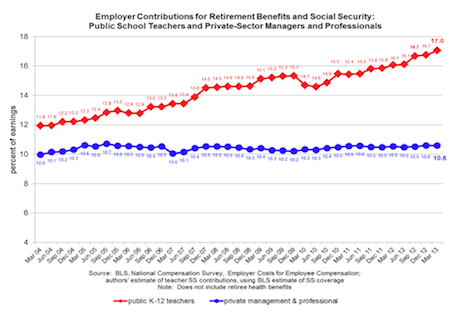In the Spring, 2009 issue of Education Next, we published an article comparing the pension costs of public school teachers with private sector professionals and administrators using data from a quarterly survey of employer compensation costs conducted by the Bureau of Labor Statistics (BLS) of the U.S. Department of Labor (“Teacher Retirement Benefits“). The article established two points. First, when expressed as a share of salaries, these costs are higher for public school teachers as compared to private sector professionals. Second, the gap has widened over time.
The time-series data we used in that article began in March, 2004, the first quarter that the BLS released such data for public school teachers, and ended in September 2008, the last quarter of data available when we wrote the article. In the conclusion to the article, we discussed some factors that could affect the future trend in these relative costs. Private sector professionals are nearly universally in defined-contribution retirement plans. In such plans both employers and employees make fixed annual contributions to a retirement account controlled by the employee. The employer’s cost is controllable in that it is not affected by external factors such as a stock market decline. By contrast, nearly all public school teachers are in defined benefit plans, in which it is up the employer to put aside sufficient funds each year to finance the future benefits of active and retired employees. This is an inherently uncertain exercise, which depends among other things on predicted future stock market returns. If the market performs below expectations, the employer will have to increase contributions to make up the shortfall. In this sense, employer costs for private professionals are “under control” while in teacher plans they are not.
Given the above factors, the sharp stock market decline in 2008, and the subsequent increase in the unfunded liabilities of the teacher pension plans, we wrote the following:
“In short, there are good reasons to believe that the contribution gap we have documented will continue to widen in coming years.”
We were right.
The chart below updates the time series to the most recent available quarter (March 2013). The results are striking. While the private sector costs are relatively stable at around 10.5 percent of salaries, the school costs have climbed from 11.9 percent of salaries in March 2004 to 14.6 percent when we wrote our piece, to 17.0 percent today. Hence, the cost gap has increased from 1.9 to 6.4 percent of salaries.
As large as the increase in public school costs are, they are understated since they do not include increases in teacher contributions. In response to the sharply rising pension costs, some states have increased the required contribution from teachers. While this does not show up on the books as a cost for schools, it represents a cut in real teacher pay, hence may hamper teacher recruitment and retention. In two states (Illinois and Ohio), the contributions of entering teachers now exceed the value of their benefits — they are being taxed to pay for the unfunded benefits of previous cohorts.
These pension costs are real. They are crowding out other school spending and are leading to layoffs of young teachers. A number of states have significantly reduced benefits and raised eligibility conditions, so it is possible that current trends will abate. However, almost all of the states enacting reforms have maintained the same defined benefit structure for their plans. The underlying problem is that benefits are not tied to contributions. As we have argued elsewhere, there are various ways to do this (cash balance plans, defined contribution, and hybrids), but without fundamental change, schools will continue to be vulnerable to cost hikes beyond their control.

—Robert M. Costrell and Michael Podgursky


